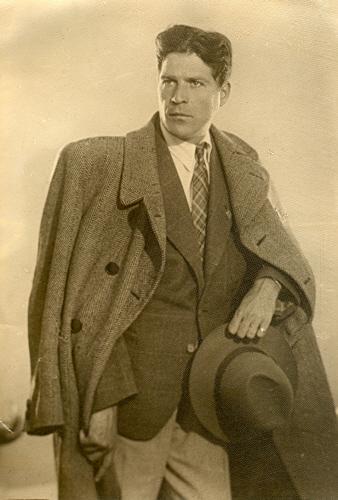
Edward Winter

C.N. 5404
A pointless tale, often repeated (e.g. The Bright Side of Chess, by Irving Chernev, page 19), is that at Nottingham, 1936 Salo Flohr thought he would win all the prizes because he heard the lift operator say ‘First Flohr, Second Flohr, Third Flohr’.
Before the story is printed yet again, it would be as well to mention that it had already been given in CHESS for 14 November 1935 (page 115), where the witticism is credited to Lilienthal. Since the writer of the article in question is George Koltanowski, one must be doubly sceptical.
(887)
‘Everywhere, it seems, adventure and anecdote awaited me’, Koltanowski writes on page 37 of Adventures of a Chess Master, neglecting to add that some of the anecdotes lurked in contradictory forms. An example is the ‘First Flohr’ yarn reported by him in a CHESS article (see C.N. 887) as having been told to him by Lilienthal. But on page 45 of his book With the Chess Masters (Falcon Publishers, 1972) he relates that Flohr himself was the speaker.
(1234)
From page 8 of Kings of the Chess Board by Lajos Steiner (Roseville, 1948):
‘I was not really surprised when, before the Hastings Christmas Tournament of 1934, Lilienthal half jokingly told me that he would beat Capablanca with a queen sacrifice, then he would give Capablanca his autograph. Lilienthal could never forget that in Paris a few years previously Capablanca refused to give him his autograph. And, to the surprise of the spectators, Lilienthal’s prophecy came true! Never in his life was Capablanca so crushingly defeated by a queen sacrifice.’
We would like other examples of prophecies that were fulfilled.
(1294)
See Chess Predictions.
A Chess Omnibus had this footnote on page 308:
Another straightforward example of K. Whyld’s propensity for distortion and untruth is his assertion (Kingpin, Summer 1997, page 61) that on page 264 of Chess Explorations we ‘savaged’ Irving Chernev over a Lasker/Capablanca matter. The public record is 100% clear there too ...
Below is the complete passage on page 264 of Chess Explorations:
C.N. 564 quoted from pages 38-39 of Chernev’s Wonders and Curiosities of Chess:
‘A strange disaster occurred to Lasker and Capablanca in 1934. Alekhine beat Lasker at Zurich in 26 moves, sacrificing his queen to do so; Lilienthal beat Capablanca at Hastings in 26 moves, sacrificing his queen to do so!’
Alas, the Lilienthal-Capablanca game was played on 1 January 1935.
Would anyone other than K. Whyld suggest that the above passage ‘savaged’ Irving Chernev?
Harald E. Balló (Essen, Germany) draws attention to the episode related in Lilienthal’s autobiography, a German edition of which was published in 1988. Lilienthal records (page 67 of the German edition) that before the last round of Hastings, 1934-35 he was in a position to share 4th and 5th places with Capablanca if the Cuban won his game against Botvinnik. In a slightly worse position, Botvinnik offered Capablanca a draw, but the latter said he would accept only if Lilienthal agreed. Botvinnik’s friend and second, Weinstein, therefore took a taxi to the hotel to seek Lilienthal’s ‘permission’. Lilienthal returned to the playing room, thanked Capablanca for his sportsmanship and agreed to the draw. And so Lilienthal shared 5th-6th places instead of the 4th-5th he would have shared had the Cuban won.
We would comment that, as is often the case, scrutiny of the contemporary record creates complications. Firstly, the leading scores before the final round were: Thomas: 6½. Euwe: 6. Flohr: 5½. Capablanca: 5. Botvinnik: 4½. Lilienthal: 4½. The February 1935 BCM (page 57) remarks that ‘a 26 to 1 chance had to come off in this [the final] round to bring about a triple tie. Thomas had to lose, Euwe had to draw and Flohr to win; and it was so.’ If Capablanca had beaten Botvinnik he would have finished clear fourth with 6 points even if Lilienthal had won instead of drawing his last-round game against Menchik. With the Cuban only drawing, Lilienthal could have finished level with him, ahead of Botvinnik, if he had defeated Menchik. In fact, their game (with Lilienthal as White) was drawn, to the surprise of some, after 38 moves in the following position (White to move):
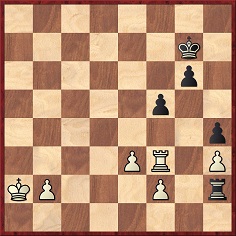
(1904)
A game included in The Paris Opening (1 Nh3):
Savielly Tartakower – Andor Lilienthal
Paris, 1933
Paris Opening
1 Nh3 d5 2 g3 e5 3 f4 Bxh3 4 Bxh3 exf4 5 O-O fxg3 6 hxg3 Nf6 7 d3 Nc6 8 Nc3 Bd6 9 Bg5 Bxg3 10 Bxf6 gxf6
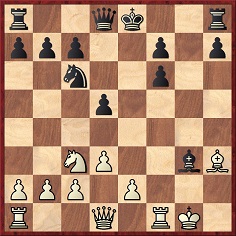
11 e4 Rg8 12 Nxd5 Be5+ 13 Kh1 Qd6 14 c3 Rg3 15 Qh5 Rxd3 16 Rad1 Rxd1 17 Rxd1 Ne7 18 Ne3 Qc5 19 Qxh7 Resigns.
The following endnote is on pages 259-260 of Chess Explorations:
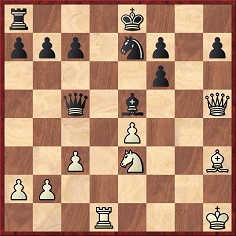
Position after 18...Qc5
On page 415 of the 14 August 1938 CHESS Tartakower gave the finish as ‘19 QxRP and White wins easily’. In 1995 Richard Forster pointed out that after 19 Qxh7 Black could have resisted with 19...f5 20 Nxf5 Qf2. Our correspondent also mentioned that 19 Bd7+ would have won easily: A) 19...Kf8 20 Qh6+ Kg8 21 Nf5 Nxf5 22 Bxf5, or B): 19...Kd8 20 Qxf7 c6 21 Bg4+ Kc7 22 Rd7+ Kb6 23 Qb3+ Ka5 24 Nc4+. In the latter line the alternative 23...Qb5 loses to 24 Nc4+ Kc5 25 Qa3+ Kxc4 26 Be2 mate (Myers).
The April 2002 book reviews at the Chess Mail website offer the spectacle of John Elburg passing strictures on the quality of English prose in a recent Lilienthal book:
‘Unfortunately the English translation and layout of this work is not perfect done, for example the gamers are to much compressed together and some translations are horrible.’
(2531)
Page 113 of the December 1934 El Ajedrez Español reported that on 11 November Lilienthal had given a simultaneous exhibition in Bilbao against 121 opponents, scoring +97 –11 =13 with a crowd of about 2,500 in attendance.
(2949)
The performance was also mentioned by Lilienthal on page 87 of his autobiographical volume Életem, a sakk (Budapest, 1985).
Yakov Zusmanovich (Pleasanton, CA, USA) draws attention to the front cover of Életem, a sakk:
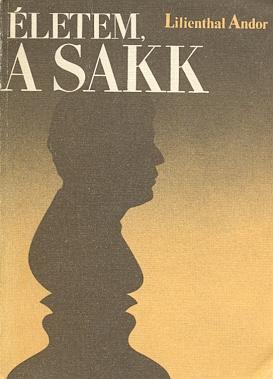
See Chess Silhouettes.
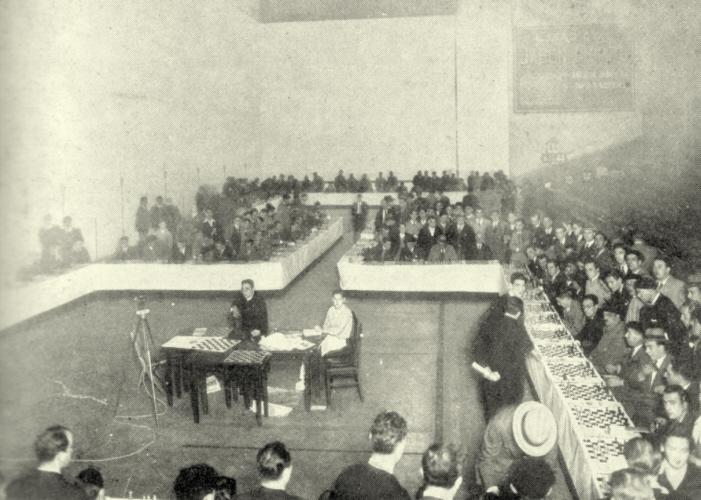
Display by A. Lilienthal, Bilbao, 1934 against 121 opponents
(3373)
See too Large Simultaneous Displays.
From Steve Wrinn (Homer, NY, USA):
‘On page 102 of his book Max Euwe (Alkmaar, 2001) Alexander Münninghoff relates that in 1934 Hans Kmoch successfully persuaded a reluctant Euwe to challenge Alekhine for the world’s championship, as Kmoch felt that “Alekhine’s form was – at least temporarily – in decline”. Münninghoff then makes three separate references to the game Alekhine-Lilienthal from the Hastings, 1933-34 tournament, which Kmoch supposedly saw as emblematic of that decline:
1. “Alekhine’s loss against the young and promising Hungarian Lilienthal was especially revealing in Kmoch’s eyes: for the first time in his career, Alekhine had been outplayed in a series of complicated tactical manoeuvres.”
2. (Münninghoff, paraphrasing Kmoch’s words to Euwe) “Didn’t you see Alekhine’s Hastings games? Don’t you know how he fumbled against Lilienthal?”
3. (Münninghoff, paraphrasing again) “Why don’t you have another look at that game of his against Lilienthal, then you will see that it wasn’t an accidental slip-up.”
I find all this rather perplexing, as Alekhine lost no games at Hastings, 1933-34, and in fact defeated Lilienthal in the game in question. Moreover, a quick check with Fritz indicates that Alekhine never stood worse during the tactical phase of that game; nor did he “fumble” or “slip up”. How Münninghoff can be so mistaken about a game that he himself considers the central topic in a “conversation that would have a decisive impact on the history of chess” is a mystery to me.’
We offer a few comments:
a) The original (1976) Dutch edition of Münninghoff’s book (pages 148-149) had a similar account. Euwe was listed as a co-author (for the annotations) and he also contributed the Foreword.
b) Kmoch wrote the chapter on Euwe in the former world champion’s book Zóó schaken zij! (Amsterdam, 1938). On page 151 he noted Alekhine’s relative failure at Hastings, 1933-34 but made no mention of the Lilienthal game. The chapter was expanded for the English edition, i.e. Meet the Masters (London, 1940), but there was still no reference to Lilienthal. To quote from page 258:
‘Then came a break in his chess career through his devoting himself to his mathematical studies for a while. Alekhine’s slight lapse in the Christmas tournament at Hastings, 1933-34 suddenly gave him the idea of challenging the now world champion to another match, and by the summer of 1935 the great event had been arranged.’
c) On page 123 of his monograph Max Euwe (Berlin and Leipzig, 1938) Kmoch stated that one January evening in 1934 he and Euwe were discussing Alekhine’s performance at Hastings (equal second with Lilienthal behind Flohr), and the conversation turned to the fact that Euwe had a 7-7 score against Alekhine in their last 14 games. No other master had put up such resistance against the world champion, and that evening Euwe decided to challenge him for the title. For the record, Kmoch’s original text is reproduced below:
‘Im Januar wohnte ich bei Dr. Euwe. Eines Abends sassen wir beisammen und plauderten über das letzte Weihnachtsturnier in Hastings, wo Flohr den ersten Preis gewann, während Aljechin und Lilienthal die zwei folgenden Preise teilten.
Es bedeutete damals noch eine grosse Sensation, wenn Aljechin einmal nicht Erster wurde, und so kam es, dass sich unser Gespräch bald nur noch um den Weltmeister drehte. Natürlich kamen auch die Ergebnisse der Spiele zwischen Euwe und Aljechin zur Sprache: 7:7 aus den letzten 14 Partien, ein prachtvoller Erfolg für den Holländer. Keinem anderen Meister der Welt ist es geglückt, Aljechin so guten Widerstand zu bieten (welche Feststellung übrigens auch heute noch zutrifft). Und irgendwie kam es, dass Euwe an diesem Abend den Entschluss fasste, Aljechin zum Kampf um die Weltmeisterschaft herauszufordern.’
d) We can supply no explanation for Münninghoff’s statement that Alekhine lost to Lilienthal or for his belief that the game was otherwise significant.
e) Pre-1934 predictions that Euwe had chances of becoming world champion are not too difficult to find. For example, the text below appeared on page 54 of the February 1931 BCM:
‘The popular Dutch champion is still under 30, so he should be a strong candidate for the world championship before long.’
On the other hand, we note the following on page 3 of the January 1936 BCM:
‘Euwe has fulfilled the prophecy of Dr Emanuel Lasker, when he was still a boyish student, that he would one day win the world title.’
When and where did Lasker make such a prediction about Euwe?
(3348)
An item in Chess and Radio:
Pages 85-87 of The Unknown Capablanca by David Hooper and Dale Brandreth (London, 1975) gave a draw between Capablanca-Kmoch and Euwe-Lilienthal, Hilversum, 16 January 1935. ‘As the moves were played so they were broadcast on the radio. Three grandmasters took part, an unusual event which drew a huge audience.’
Calle Erlandsson (Lund, Sweden) writes:
‘Wojciech Bartelski, the editor of OlimpBase, has noticed that ChessBase has the identical game-score for the encounters between Lilienthal and Bolbochán at the sixth Olympiad (Warsaw, 1935) and at the seventh (Stockholm, 1937):
1 d4 Nf6 2 c4 e6 3 Nc3 d5 4 Bg5 Nbd7 5 Nf3 c6 6 e4 dxe4 7 Nxe4 Be7 8 Nc3 c5 9 Qc2 cxd4 10 Nxd4 h6 11 Bh4 O-O 12 Be2 a6 13 O-O Qb6 14 Rad1 Re8 15 Bg3 Nf8 16 Na4 Qa5 17 c5 Nd5
18 Nb6 Nxb6 19 Nb3 Qa4 20 cxb6 Bf6 21 Bf3 e5 22 Rfe1 Qb5 23 Qc5 Re6 24 Qxb5 axb5 25 Nc5 Rxb6 26 Bxe5 Bf5 27 Bc7 Rc6 28 Bxc6 bxc6 29 Be5 Rxa2 30 Bxf6 gxf6 31 Rd2 Ng6 32 h3 h5 33 Ne4 Bxe4 34 Rxe4 Kg7 35 Re8 c5 36 Rb8 b4 37 Rb5 Ra1+ 38 Kh2 Rc1 39 Rd5 Rc2 40 Rdxc5 Rxb2 41 Rxh5 Rxf2 42 Rxb4 f5 43 Kg1 Resigns.
Furthermore, this same game was given on pages 186-189 of The Lost Olympiad Stockholm 1937 by W.H. Cozens (St Leonards on Sea, 1985) and on pages 141-142 of VI Wszechświatowa Olimpiada Szachowa Warszawa 1935 by M. Litmanowicz (Warsaw, 1995). Although Cozens included detailed annotations, the game was indeed played in Warsaw.
The Stockholm game between the two players began 1 d4 Nf6 2 c4 e6 3 Nf3 d5 4 Nc3 Nbd7 5 e3 Be7 6 Bd3 c5 7 O-O O-O. The complete game-score and the 683 others from the Stockholm Olympiad are scheduled to be published in an extensive book by Peter Holmgren and me in 2007.’
Below are photographs of the Argentinian team at the 1937 Olympiad in Stockholm, from page 273 of El Ajedrez Americano, September 1937. The Bolbochán at both Olympiads was Jacobo, the brother of Julio.
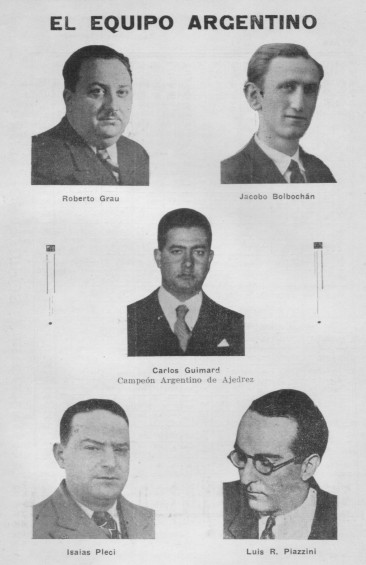
(3892)
From Christian Sánchez (Rosario, Argentina):
‘In Especial Ocho x Ocho, September 1994 (page 15) Fernando Visier wrote: “En los análisis de partidas aplazadas llámase ‘sistema Lilienthal’ a buscar de antemano una continuación que asegure el empate, y a partir de ahí avanzar a cotas más ambiciosas.” (English translation: “In analysis of adjourned games, the ‘Lilienthal system’ consists of, firstly, searching for a way to achieve the draw and then seeking better prospects.”)
When was this method first attached to Lilienthal’s name?’
(4973)
Javier Asturiano Molina (Murcia, Spain) quotes from pages 187-188 of Think Like a Grandmaster by A. Kotov (London, 1971):
‘Adjourned positions sometimes occur in which it is hard to forecast the result. You come home thinking you are going to win. You examine it and find it is nothing like as simple as you thought, and are taken aback. In such cases we often say jokingly to each other, “Let us apply the ‘Lilienthal principle’”.
The point is that this experienced grandmaster and trainer always starts analysing a position by asking himself if he can draw it, and only when he finds that he has at least a draw does he start looking for a way to win it. Try this method and you will find that your analysis becomes more exact and not so long-winded.’
(5003)
See also C.N. 7075 in our feature article on Bent Larsen.
Frederic Friedel (Hamburg, Germany) has sent us three photographs of Andor Lilienthal:

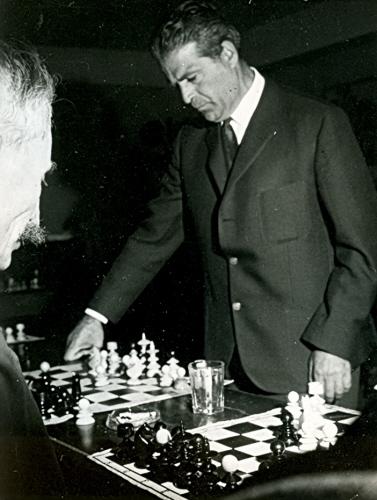
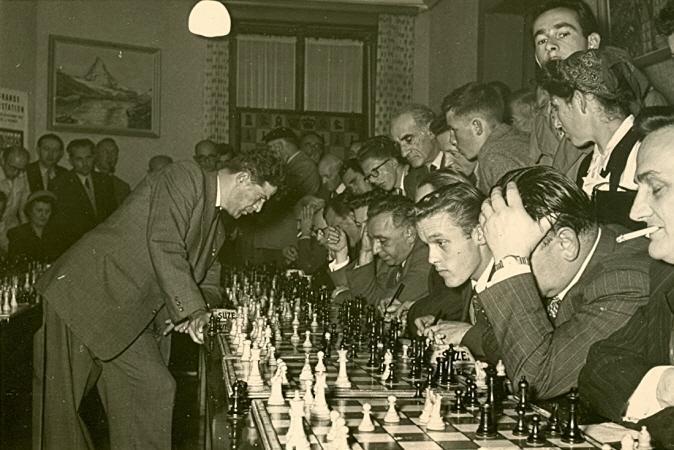
(5404)
A further selection of photographs of Lilienthal from our collection:
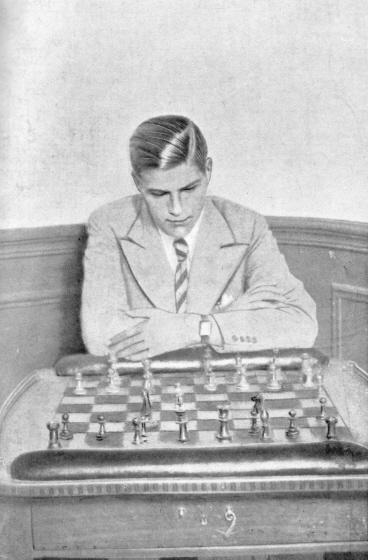
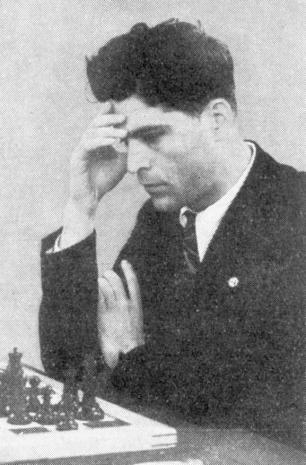
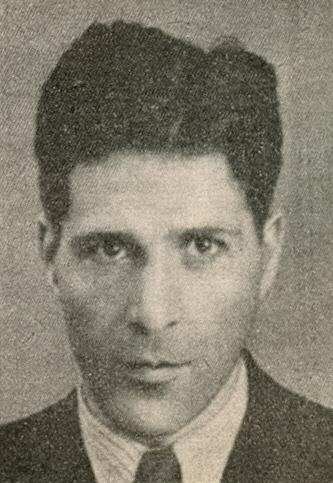
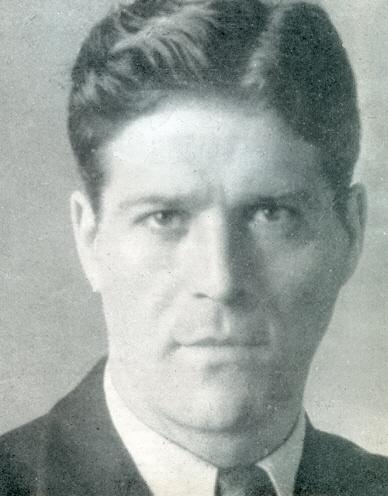
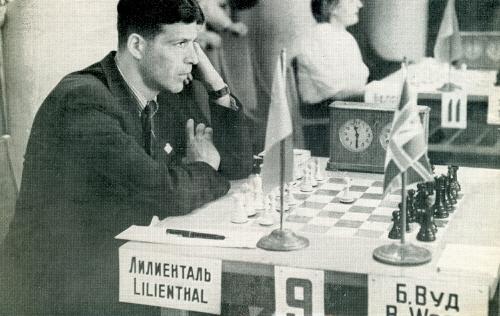
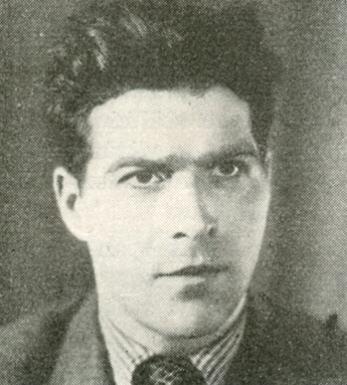
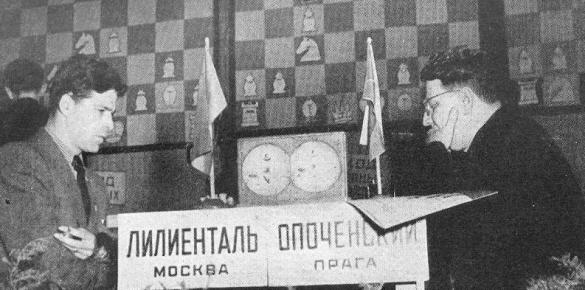
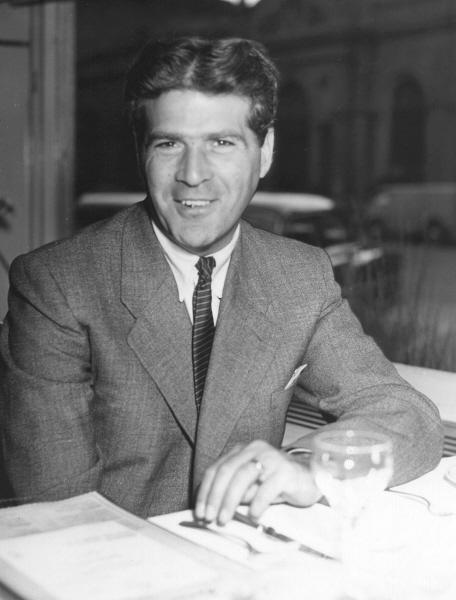
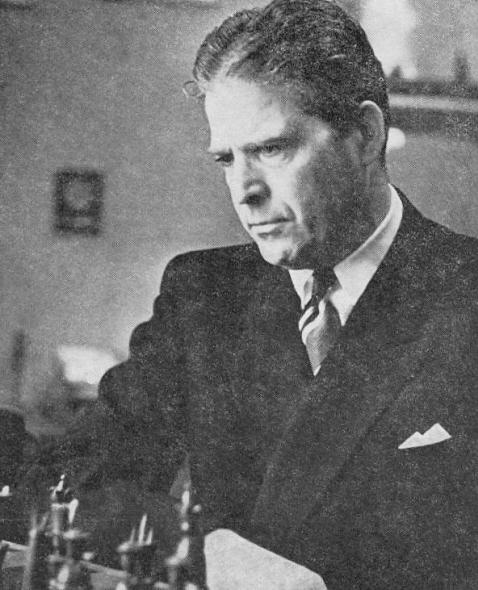
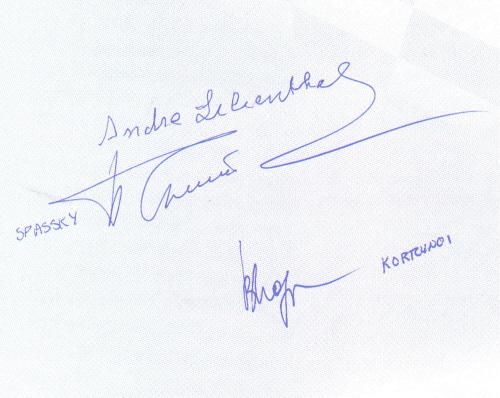
(6569)
Lilienthal never defeated Alekhine in a tournament but was successful against him in blitz play. Since confusion sometimes arises over the matter, we reproduce the account provided by Lilienthal on page 24 of his autobiographical work Életem, a sakk (Budapest, 1985):
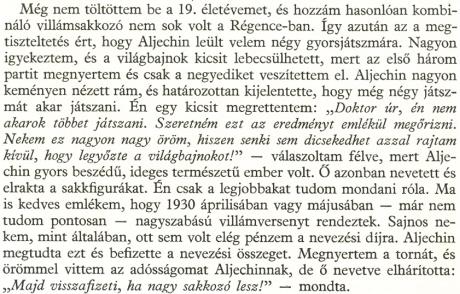
Below is the German translation, from pages 19-20 of Schach war mein Leben (Thun, Frankfurt/Main, 1988):
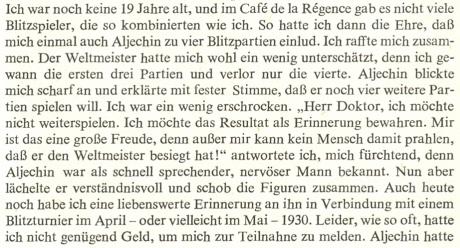

(6570)
Karel Mokrý (Prostějov, Czech Republic) informs us that he investigated this Moscow, 1935 photograph in the 1980s and drew up the key given below:
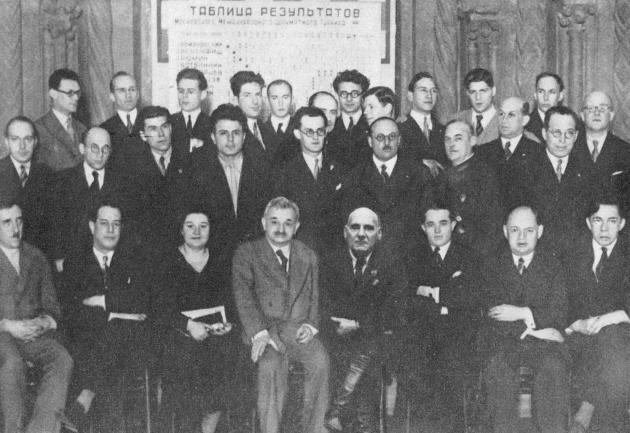
Mr Mokrý also mentions an article which he has written on the two variations of the Russian-language tournament book and the subsequent removal of Krylenko’s name and contribution. See under ‘Moscow 1935’ in the ‘Collector’s Corner’ of our correspondent’s webpage.
(7286)
From Photographs of Capablanca, a feature article which appealed for better copies of a number of images in Soviet publications:
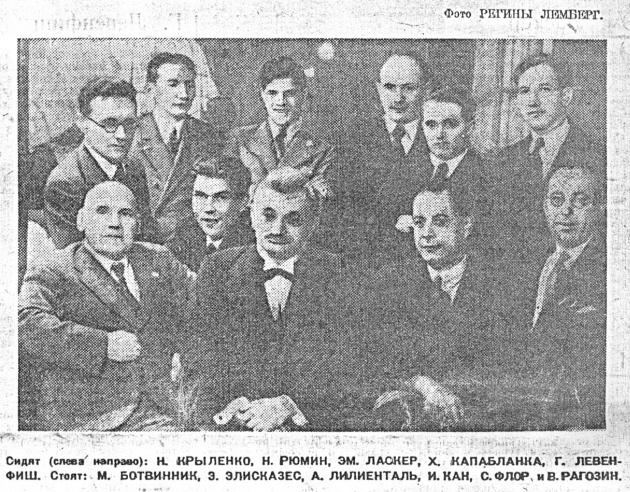
Source: Moscow tournament bulletin, 64, 13 June 1936 and 64, 16 June 1936, page 1
In C.N. 7301 Philippe Pierlot (Le Perchay, France) provided a good-quality copy (source not yet identified):
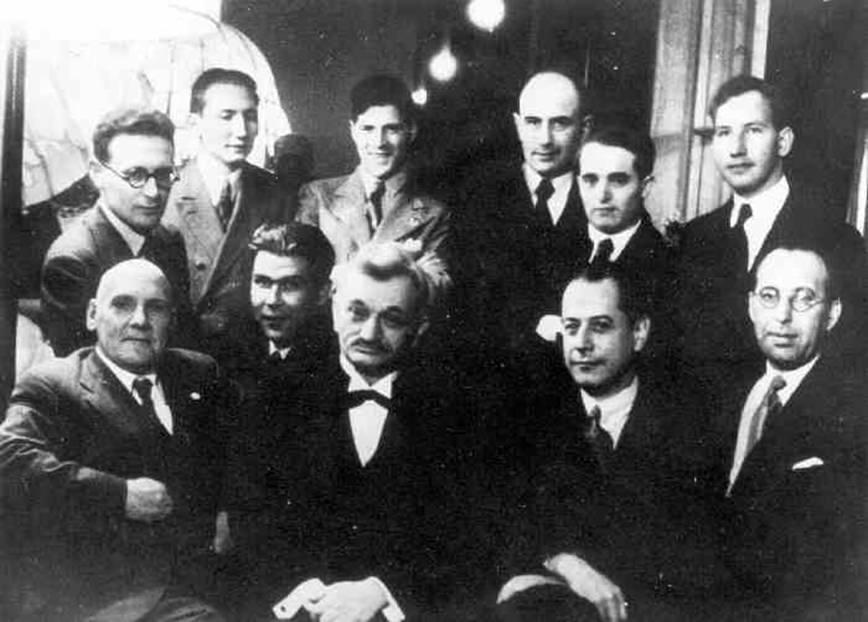
Paul Keres – Andor Lilienthal
USSR Absolute Championship, Moscow, 27 April 1941
Falkbeer Counter-Gambit
1 e4 e5 2 f4 d5 3 exd5 e4 4 d3 exd3 5 Bxd3 Nf6 6 Nc3 Be7 7 Nf3 O-O 8 O-O Nbd7 9 Bc4 Nb6 10 Bb3 a5
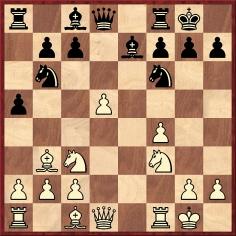
11 a4 Bc5+ 12 Kh1 Bf5 13 Ne5 Bb4 14 g4 Bc8 15 Be3 Nbd7 16 g5 Bxc3
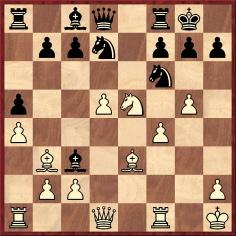
17 bxc3 Ne4
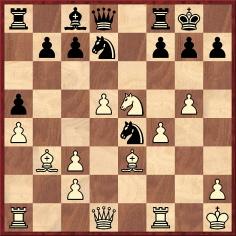
18 d6 Nxe5 19 fxe5 Resigns.
The present item will focus on the concluding moves, but a word first about the opening. Some databases give the move order as 4 Nc3 Nf6 5 d3 exd3 6 Bxd3 Be7; seldom can a database be consulted for an old game without an error or discrepancy of some kind being found.
The annotator of a miniature may be tempted to view matters (or, at least, pretend to) as a plain lesson in crime and punishment, the loser being doomed almost from the start and the winner’s play being presented as irreproachable. In Keres v Lilienthal, after 15...Nbd7 Reuben Fine commented:
‘One’s reaction to this move is that if such things have to be done he might as well resign.’
And after 16...Bxc3:
‘To have some air, but he loses a piece. The position is hopeless.’
Following 17 bxc3 Ne4 Fine gave 18 d6 two exclamation marks and wrote:
‘Typical. Black’s game is ripped apart.’
Black’s reply, 18...Nxe5, was labelled ‘desperation’ since 18...Nxd6 allowed an ‘elegant’ mating variation.
Page 82 of Chess Marches On! by Reuben Fine (New York, 1945)
A similar story of inexorable comeuppance was told by Fred Reinfeld. At move 15: ‘Black’s helplessness is touching.’ At move 16 an alternative was rejected because in that case ‘Black has no reasonable continuation’. And, as in the Fine book, two exclamation marks for 18 d6.
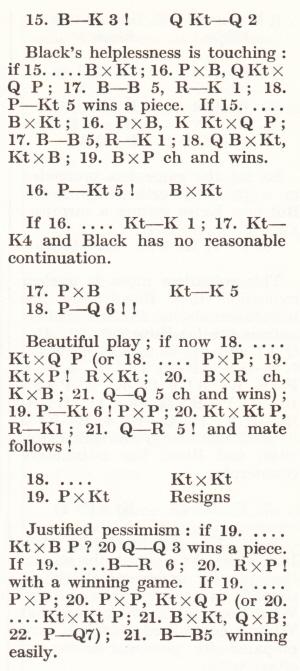
Page 225 of Keres’ Best Games of Chess, 1931-1948 by Fred Reinfeld (New York, 1949)
Strange to relate, in 1941 the notes to Keres v Lilienthal were less eulogistic of White’s play at various points. Below is the game’s appearance on pages 96-97 of the tournament book, 6 notables maestros by S. Belawenetz and M. Judowitsch (Buenos Aires, 1941):
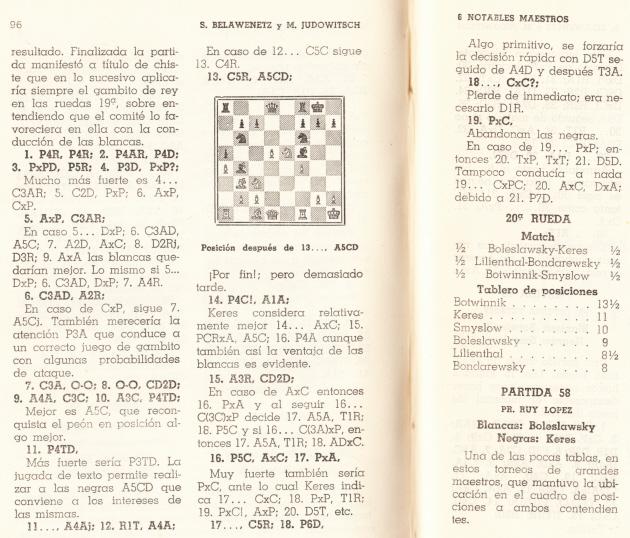
Moreover, Keres himself was critical of his play in two publications in 1941. The first was in a letter dated 9 May 1941 to B.H. Wood given on page 178 of the September 1941 CHESS. It will be seen that he even appended a question mark to 18 d6:
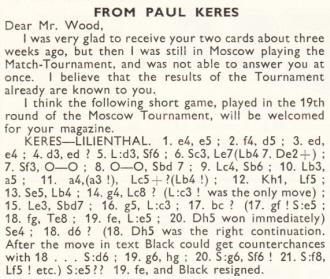
Keres annotated the game in detail on pages 207-208 of the November 1941 Chess Review, criticizing his play and stating that at move 18 ‘Lilienthal missed an excellent chance for salvation’:
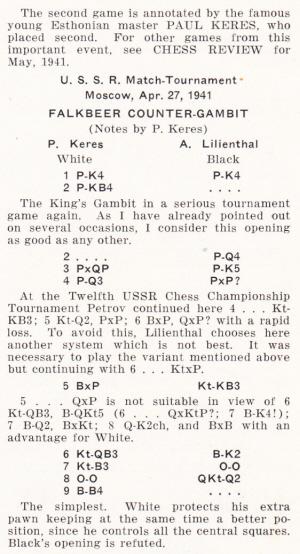
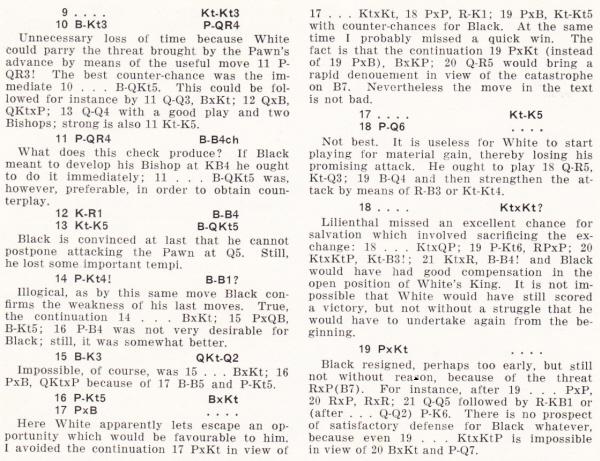
Finally, below are Botvinnik’s annotations in the English edition of his book on the tournament, on pages 179-180 of Championship Chess (London, 1950):
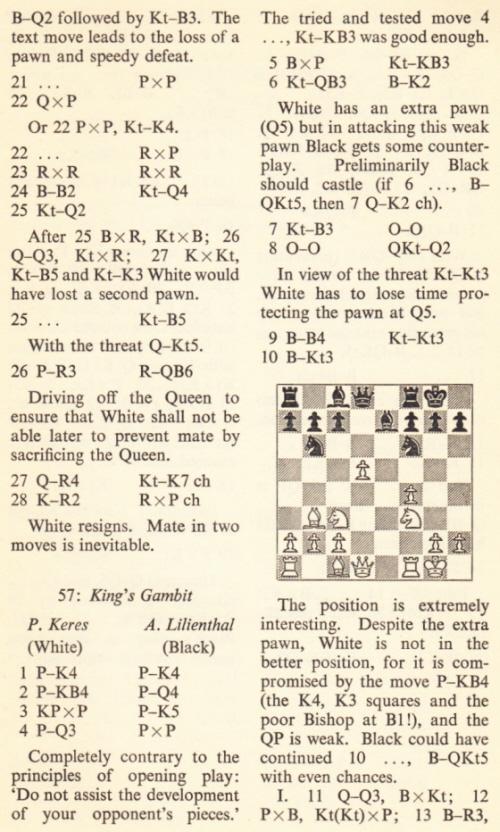
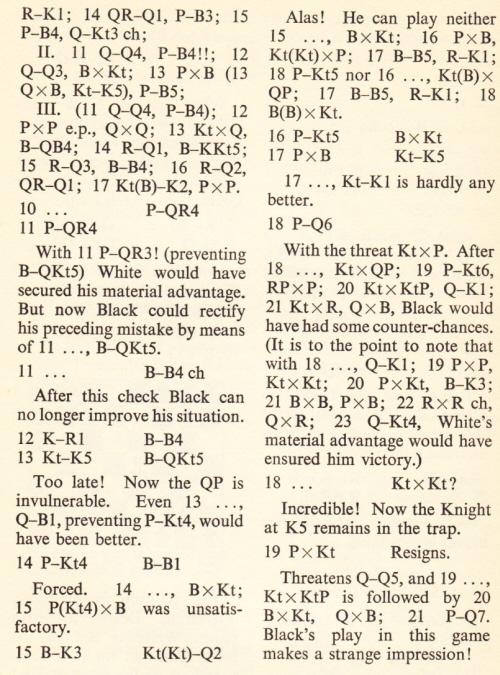
A photograph taken during the Leningrad part of tournament was published on page 206 of the November 1941 Chess Review:
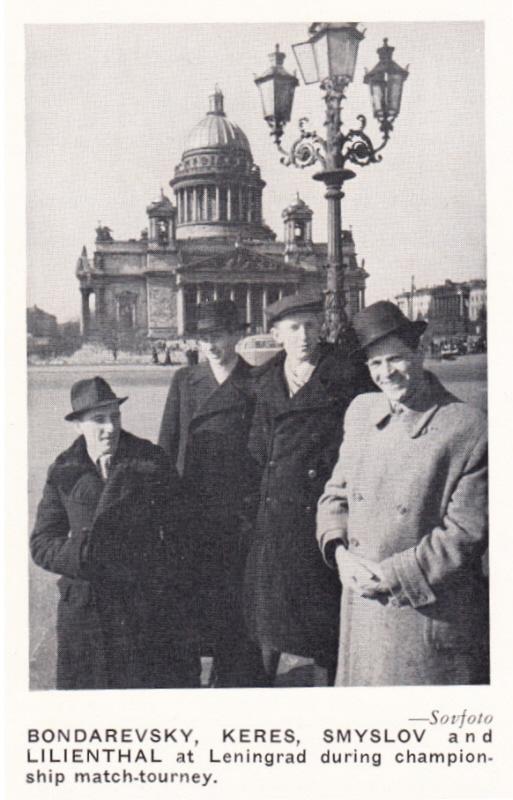
(8353)
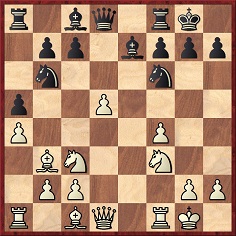
Black to move
The above position arose after 11 a4 in Keres v Lilienthal, USSR Absolute Championship, Moscow, 27 April 1941. As shown in C.N. 8353, 11...Bc5+ received this remark from Keres in his annotations on pages 207-208 of the November 1941 Chess Review:
‘What does this check produce? If Black meant to develop his bishop at KB4 he ought to do it immediately; 11...B-QKt5 was, however, preferable, in order to obtain counterplay.’
A briefer criticism of 11...Bc5+, on page 81 of Chess Marches On! by Reuben Fine (New York, 1945), is what passes in the chess world for a dictum/maxim/witticism:
‘Evidently forgetting that nobody ever died of a check.’
(10678)
David McAlister (Hillsborough, Northern Ireland) provides a photograph of James J. Doyle with Lilienthal in the Dublin Evening Herald of 8 January 1935, page 10:
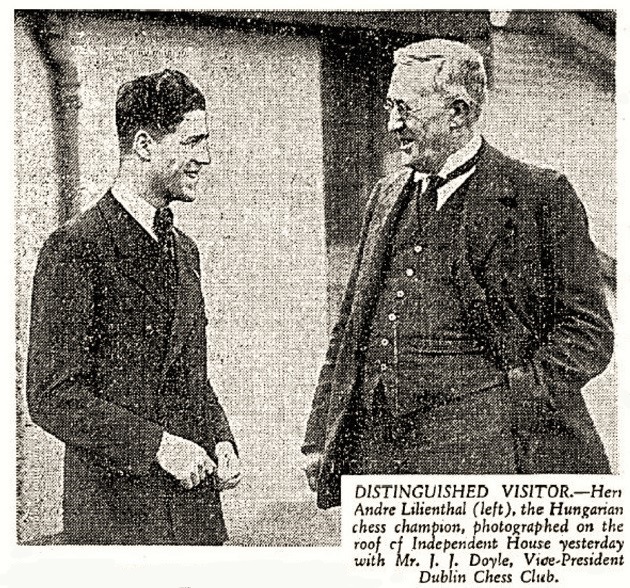
(10534)
Regarding the photographer Theodore Lilienthal of New Orleans, see C.N. 5173.
From C.N. 6348:
Jim Kulbacki (Cheyenne, WY, USA) draws attention to the poem ‘Chess Players’ on pages 120-124 of Blood of Things by Alfred Kreymborg (New York, 1920). We find it especially intriguing for two apparently prescient references to a player named Lilienthal. Here, for example, are the last few lines of the poem:
(6348)
To the Archives
for other feature articles.
Copyright Edward Winter. All rights reserved.